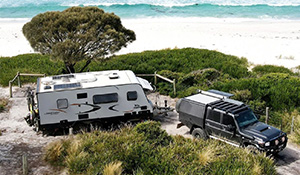HiLux transformed into firefighting vehicle
In response to the difficulties involved in extinguishing EV fires, particularly in confined areas like multi-storey carparks, British company Prospeed Motorsport has developed the HILOAD, a firefighting vehicle based on the current generation Toyota HiLux dual-cab ute.

Although electric vehicles are less likely to catch fire than those with an internal combustion engine, outbreaks involving a lithium-ion battery can be far more serious and difficult to extinguish. Once a battery pack has been compromised by an accident or external fire, it can be difficult to tackle the resulting blaze, as energy contained within the cells is released, causing a ‘thermal runaway’.
Existing measures of combatting EV fires require excessive amounts of water and can even involve immersing the entire car in water for days.
HILOAD offers a new, more practical way of tackling these incidents, and being more compact, can deliver the firefighting crew and equipment to enclosed spaces, such as an underground car park, that some large fire engines cannot access.

Based on a Toyota HiLux dual cab, the HILOAD is engineered by Prospeed Motorsport in York, England, and features a longer, bespoke chassis, chiefly to incorporate an additional rear axle, which is driven and allows for the extra weight and bulk of the HILOAD’s water tanks and fire-fighting gear.
Against a standard HiLux 4x4 dual cab’s tub that is 1,570mm long, the HILOAD’s length aft of the cabin is 2,800m. While it is 1,230mm longer, the HILOAD’s height is actually lower than the 1,865mm of a current model HiLux SR5 at just 1,850mm – ensuring the firefighter remains low enough to enter most parking structures.
With its new chassis and six-wheel drive with a torque splitter, the HILOAD has a payload of 3,000kg – more than three times a standard HiLux 4x4 dual cab – and GVM of 5,600kg.

EV-specific firefighting equipment in the HILOAD includes the ‘Coldcut Cobra’ system that uses an abrasive suspended in water to pierce a hole through an EV’s floorpan and inject water at 300bar – more than 100 times the pressure of the air in a typical car tyre – into the battery module casing, preventing propagation and further possibility of a thermal runaway.
Unlike alternatives that involve pumping thousands of litres of water into the vehicle in an attempt to cool the whole battery, independent tests from the Swedish Civil Contingencies Agency showed Coldcut Cobra can prevent cell propagation in 10 minutes, using just 240 litres of water – less than an average bath and just 20 per cent of the HILOAD’s tank capacity.

A HILOAD is currently being trialled in Czechia, with the vehicle specifically developed to tackle EV battery fires and assist with fast-response occupant extraction. Another HILOAD is part of one EV car manufacturer’s firefighting fleet.
While it’s designed for urban environments, Prospeed says the enhanced traction from the HILOAD’s six-wheel drive also make it valuable for tackling fires in the bush and other challenging environments.
The HILOAD is assembled in the UK, but Prospeed says can ship the 6x6 conversion as a kit for final assembly in an export market. The design can also be licenced for higher volume production.
Prospeed’s future plans include a 6x6 HILOAD with an even greater 6,500kg GVM and a 4x4 version with a 5,000kg GVM for military applications, aimed at replacing the ageing Land Rover Defender and Pinzgauer in the UK’s defence fleet.









